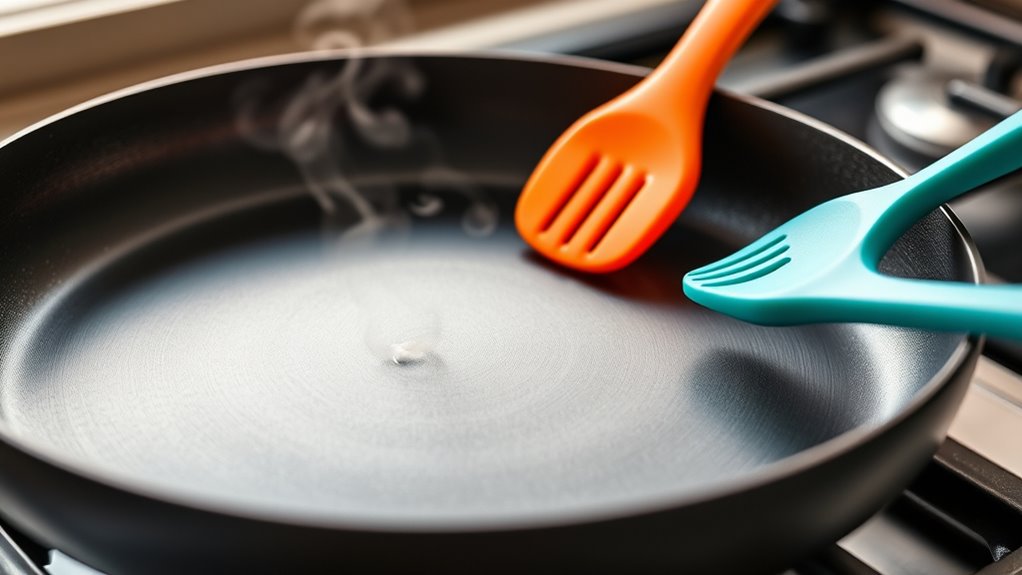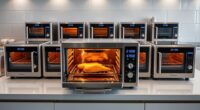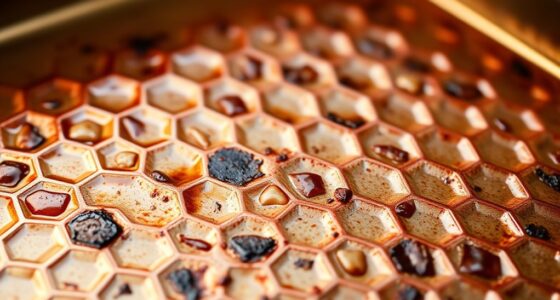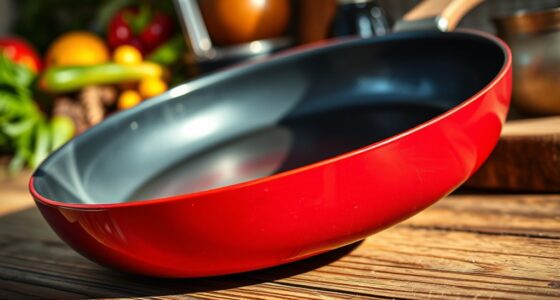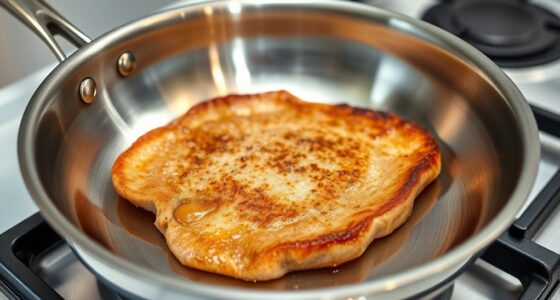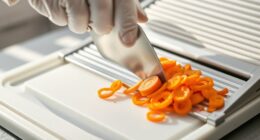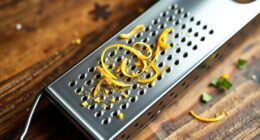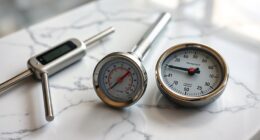To keep your nonstick cookware safe, avoid using metal utensils that can scratch or gouge the coating. Stick to silicone, wood, or plastic tools to prevent damage. Cook on medium or low heat, as high temperatures above 500°F can harm the coating and release harmful fumes. Proper care extends your cookware’s lifespan and keeps your food safe. Want to learn more about protecting your nonstick surfaces? Keep exploring for expert tips.
Key Takeaways
- Most nonstick coatings are safe at medium heat; avoid exceeding 500°F to prevent damage and fumes.
- Use silicone, wood, or plastic utensils to prevent scratching and preserve coating integrity.
- High temperatures and abrasive cleaning can accelerate wear, exposing metal and releasing particles.
- Regularly inspect for scratches or chips; damaged coatings should be replaced to ensure safety.
- Consider durable alternatives like stainless steel, cast iron, or ceramic for long-lasting, safer cooking.
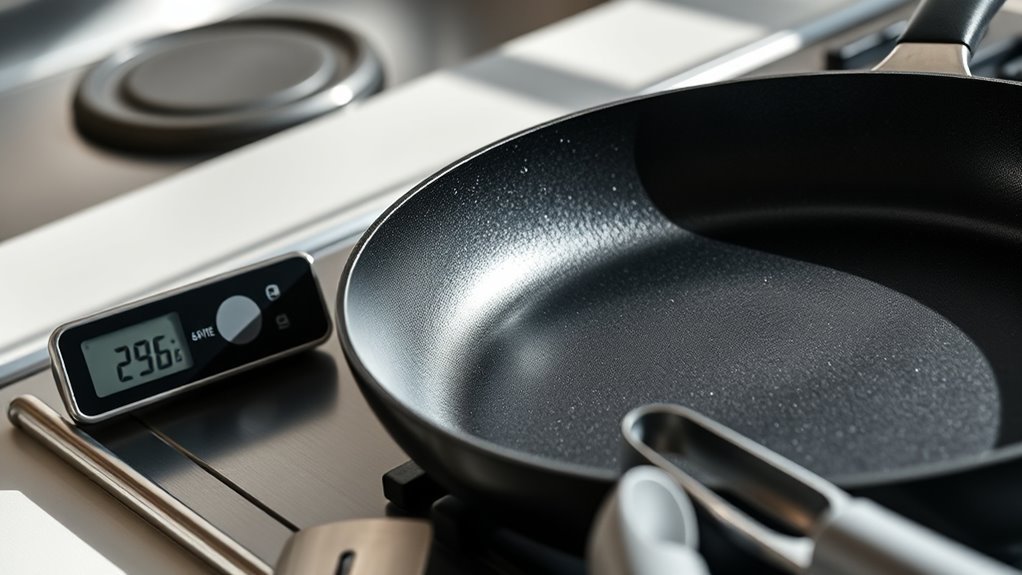
Have you ever wondered if your nonstick cookware is safe to use? It’s a common concern, especially as many people rely on nonstick pans for quick, easy meals. One of the main issues centers around the durability of the nonstick coating. Over time, with frequent use and improper handling, the coating can wear thin or chip away, exposing the underlying metal and potentially releasing harmful particles into your food. To extend the lifespan of your cookware and maintain its safety, it’s essential to understand the factors that influence nonstick coating durability. High heat, abrasive tools, and dishwasher cleaning can all accelerate wear, leading many to seek alternative cookware options. These alternatives—such as stainless steel, cast iron, or ceramic cookware—offer different benefits and may be more resilient, reducing concerns about coating degradation and ensuring safer, long-term use.
Worn nonstick coatings can release harmful particles; choose durable, safer cookware options for long-term kitchen use.
Knowing the right temperatures to cook with is vital. Most nonstick coatings are designed to withstand medium heat, but exceeding this can cause the coating to break down faster. When you cook at high temperatures, especially above 500°F, you risk damaging the nonstick layer and releasing potentially harmful fumes. It’s smart to keep your stove’s heat at medium or low to preserve the integrity of the coating. If you often find yourself needing higher heat, considering cookware with a more robust, heat-resistant surface might be a better choice. This way, you protect both your health and your investment, reducing the chance of coating deterioration. Additionally, being aware of air purifier maintenance can help you maintain a healthier kitchen environment by reducing airborne particles that might come from degraded nonstick coatings.
Tools matter too. Using metal utensils on nonstick surfaces can scratch, gouge, or peel the coating, decreasing its effectiveness and lifespan. Always opt for silicone, wood, or plastic tools to prevent damage. Scratches not only compromise the nonstick properties but also create tiny crevices where bacteria and grime can hide. When your nonstick cookware gets scratched or shows signs of wear, it’s time to replace it or switch to alternative options. Ceramic, stainless steel, or cast iron cookware may require different handling but don’t rely on a fragile coating that can chip or peel. These options often withstand higher temperatures and rougher utensils, providing a safer, more durable solution.
In the end, understanding how to care for your nonstick cookware—by controlling cooking temperatures and using appropriate tools—can extend its lifespan and keep your meals safe. But if you’re concerned about the durability of nonstick coatings or want peace of mind, exploring alternative cookware options might be your best move. They often come with their own safety advantages and can become reliable staples in your kitchen for years to come.
Frequently Asked Questions
Can I Use Metal Utensils on Nonstick Cookware?
You shouldn’t use metal utensils on nonstick cookware because they can scratch the surface, reducing nonstick durability. Metal tools often have sharp edges that can damage the coating, making it more prone to peeling and wear over time. Instead, opt for silicone, wood, or plastic utensils, which are gentle on your nonstick surface and help maintain its effectiveness longer. Protect your cookware by choosing the right utensils for safe, lasting use.
How Often Should I Replace My Nonstick Pans?
To keep your cookware in top shape, you should replace your nonstick pans every 3 to 5 years, depending on pan lifespan and usage. If you notice peeling, scratching, or loss of nonstick performance, it’s time for a change. Regularly inspecting your pans helps prevent food from sticking and ensures safety. Don’t delay; a fresh pan fosters flawless cooking and keeps your kitchen safe and stylish.
Are Nonstick Coatings Safe for Oven Use?
Nonstick coatings are generally safe for oven use if you follow the manufacturer’s oven temperature guidelines. Most nonstick pans can handle oven temperatures up to 350-500°F, but it’s crucial to check for any specific durability limits. Avoid exposing nonstick coatings to high heat beyond their recommended range, as this can degrade the coating and reduce its lifespan. Always use appropriate oven-safe tools to maintain the coating’s integrity.
What’s the Best Way to Clean Nonstick Surfaces Without Damage?
Think of gentle cleaning routines as the key to preserving your nonstick surface. You should use soft sponges or cloths and avoid abrasive cleaners that can scratch or damage the coating. Never scrub harshly; instead, let warm soapy water do the work. Regularly cleaning with these mild methods keeps your nonstick cookware in top shape, ensuring it remains nonstick and safe for years to come.
Do Nonstick Pans Emit Harmful Fumes if Overheated?
Yes, nonstick pans can emit harmful fumes if overheated. When you overheat a nonstick pan, nonstick fumes release, which may cause flu-like symptoms or respiratory issues. To avoid overheating hazards, keep the temperature below 500°F, use low to medium heat, and never leave the pan unattended. Proper ventilation helps, too. Always follow manufacturer guidelines to guarantee safe use and prevent the release of nonstick fumes.
Conclusion
Remember, when it comes to nonstick cookware, using the right tools and avoiding high heat keeps you safe and your pans in great shape. Some might think you need to crank up the heat for perfect searing, but that actually damages the coating. Stick to medium heat and gentle tools, and you’ll enjoy long-lasting, safe nonstick performance without sacrificing flavor or convenience. Your cookware will thank you, and so will your health.
